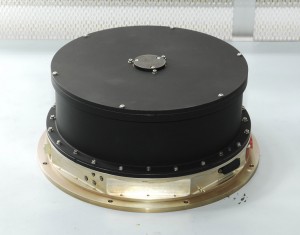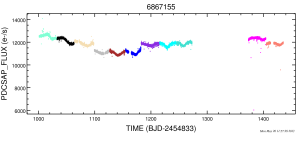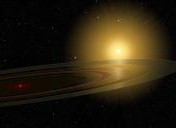You have probably heard that the Kepler Space Telescope, which has discovered various surprising planetary systems as well as small planets in the habitable zones of their stars, suffered a major technical failure last week. According to the Kepler Mission Manager Update, engineers determined that reaction wheel #4 failed to restart after the spacecraft entered a self-preserving “safe mode.” In this post, I will discuss what happened to the spacecraft and how this will affect our ability to find Earth-sized planets. The short story is that the space telescope probably won’t detect any new Earth-sized planets, but we can continue discovering such planets in the wealth of existing data.
What are the reaction wheels anyway, and why does Kepler need them?

One of Kepler’s reaction wheels, manufactured by Goodrich Corporation. The reaction wheels are gyroscopes that keep the Kepler spacecraft pointing in a fixed direction. The telescope, which has four reaction wheels, requires three to be operational at a given time to maintain its stable pointing. Reaction wheel #2 failed in July 2012. With only two operational reaction wheels, Kepler can no longer point with the accuracy required to find Earth-sized planets.
The reaction wheels, capable of spinning at 4,000 rpm, generate the angular momentum necessary to control and stabilize the telescope pointing. They are a mechanical type of gyroscope manufactured by Goodrich Corporation and contracted for the Kepler Space Telescope by Ball Aerospace.
The detection of Earth-sized planets requires extremely precise pointing of the telescope. This is because the transit of an Earth-sized planet across a sun-sized star results in a change in the star’s brightness of 1/10,000 (or 100 parts per million). Kepler was designed to detect changes in brightness of 20 parts per million, which meant it was capable of finding Earth-sized planets and smaller. To save on bandwidth, Kepler only downlinks data from the pixels associated with 156,000 target stars out of the millions of stars in the Kepler field. Data from an “aperture” of pixels around each target star are downlinked to Earth, and computer programs on Earth measure the brightness of the star based on the light that hit the pixels in the aperture. If the telescope pointing is not good enough to keep the target stars in their respective apertures on the pixels, it is impossible to measure the brightness of those stars with a precision of 20 parts per million.
Can the pointing of the spacecraft be restored?
Not to the precision required to detect changes in brightness of 20 parts per million. The Mission Manager Update offers the possibility of using the thrusters to help the telescope maintain its pointing, but it seems unrealistic to expect a crude thruster to achieve the precision of a gyroscope. Although it might be possible to point Kepler well enough to do some new science, it seems unlikely that Kepler will be able to continue discovering Earth-sized planets.

Light curve of several “quarters” of data of the Kepler target star KID 6867155. A planet candidate has been identified from transits in the light curve, but more follow-up is needed to confirm the planet. Data from the NexSci Exoplanet Archive.
Can we still find Earth-sized planets (in the habitable zone and elsewhere)?
Yes! Kepler has already given us a plethora of data that will feed hungry scientists for years to come. Buried within the 156,000 light curves of stars spanning four years are many of the tell-tale “dips” indicating the transits of planets–including small ones. The current challenge is to process the data in a manner that teases these tiny signals out of the noise and unwanted signals of stellar variability and spacecraft systematics, much like finding a needle in a haystack. The game of detecting Earth-sized planets has moved from the telescope to the computer, and I invite all of you enthusiastic data processors to take up the challenge! You can find and download the light curves of the Kepler stars from the NexSci Exoplanet Archive.
Other types of observational follow-up present major opportunities for confirming and characterizing Earth-sized planets given the existing Kepler data. Radial velocity measurements of host stars, stellar spectra, adaptive optics imaging, and speckle interferometry help rule out false positive scenarios and better characterize the planets and their stars. Additionally, transit timing variations in the Kepler data can help characterize the architectures multi-planet systems. Describing each of these follow-up methods is outside the scope of this article, but I encourage you to leave a comment if you are curious about them.
What are the major repercussions of having only four years of data instead of eight?
The “extended” Kepler Mission was supposed to run for eight years. (The original mission design was for 3.5 years, and Kepler exceeded this!) Eight years would have yielded twice as much data on Earth-sized planets, resulting in a square-root-of-two improvement in our ability to extract their transit signals from the noise.
The length of the mission corresponds to how “far-out” we can probe stellar systems. For instance, since Earth has a one-year orbital period, we would expect to see three transits of an Earth-analog (enough to identify it as a planet candidate) in three years. However, a transiting Mars-analog (with an orbital period of 1.88 years) would transit two or three times in four years, but would certainly transit three times in eight years. So the four-year Kepler Mission can find and characterize the occurrence of exoplanets out to the orbital period of Earth, but an eight-year mission could have probed as far out as the orbital period of Mars.





Ive read thousands of articles and have probably only said “great article” twice. This is the third time, great article :). You’ve taken the effort to explain the necessary details with e logical precision that most writers lack, and I appreciate this. There was nothing beyond comprehension in your article, despite going into very good detail, and not just random detail – but detail that really helps one see the forest from the trees. The pics of the gyro were also a great idea. Keep up the great work, will look for your articles from now on.
Erx
Thank you, Erx. Our mission at Astrobites is to give in-depth explanations using language that undergraduates in the sciences can understand. I am glad this article was clear to you!
would it be possible to develop a program that could be used like “Seti @ home” and make use of the millions of computers around the world to help identify possible planets from the Kepler data? Just a thought…
Hi Jim,
A similar program already exists. It’s called Planet Hunters. You can check out their website here: http://www.planethunters.org/
Planet Hunters has already discovered several planets, including a planet around a quadruple-star system. However, this citizen science project differs from SETI@home in that participants analyze the data with their eyes in their own time, rather than using their computer’s downtime to process data in the background. The disadvantage is that people are slower than computers, but the advantages are that sometimes people make discoveries that computer algorithms miss, and people who participate get to have fun and learn about hunting for planets while doing real science.
Lauren, I am a computer programmer coming from an actuarial background.
I could never understand the need for the planethunters.org site given that I know for a fact that if a human being can see the light curve fluctuations that represent the signature of a planet, I can certainly write a computer program that can do that without missing a single possible detection.
Now, my question is, is the Kepler pipeline software just limited due to a design decision, or am I totally missing something?
I understand that there are false positives that need to be accounted for, and I certainly am not talking about being able to pick them up (I wouldn’t know how unless I knew all the rules by which false positives occur), but I am talking about picking up / detecting the actual light curves – that shouldn’t be a problem in terms of the software, and I’m still curious to know why it is?
I’ve looked at the data closely and have a decent idea on how the curves are detected, but if the program was written the way i envisage, there should not be any need for people to look through the data manually.
What do you think it is? Have I missed something or is the software just not written the way it should have been?
Also, I’m not talking about multi-planet systems, of course, those are harder to detect computationally (but still possible). I am talking about a single planet around a single star, the sort that planethunters visitors detect. Also, by looking at the data manually, I am referring to the planethunters users looking at the light curves on the planethunters site.
Of course, I understand you need to look at light curves manually in multi-planet systems or in other obscure scenarios etc.
Hi ERX,
Indeed, computational programs are much faster at finding many transits around many stars than the Planet Hunters approach! The Kepler Pipeline searches for planet transits. So do software pipelines developed outside NASA. TERRA, developed by Erik Petigura at UC Berkeley, finds many of the same planets as the Kepler pipeline. QATS, developed by Eric Agol of U. Washington, can search for planets that exhibit transit timing variations.
These software packages are all excellent. They have collectively discovered over 3500 candidate planets in the Kepler data. Continued software development in these packages, the creation of new pipelines with different approaches, and the application of these packages to the full ensemble of Kepler data will increase the number of candidate planets!
However, there is still a place for Citizen Science in Kepler follow-up. Planet Hunters has made several independent discoveries, including a planet orbiting a quadruple star system (http://arxiv.org/abs/1210.3612)! The complexity of such a system is difficult to capture in a computer algorithm, so many automated searches miss such gems.
Another valuable aspect of Planet Hunters is that Citizen Science allows people who do not have professional training as scientists to take part in the discovery process. I think this is an amazing teaching tool that can inspire people and, with some teaching oversight, introduce good data analysis skills.
**UPDATE**
The NASA Kepler Team has proposed the “K2” Mission. This mission, should it win funding, will involve pointing the Kepler telescope at regions in the ecliptic plane of our Solar System (http://en.wikipedia.org/wiki/Ecliptic). This orientation of the spacecraft, given the spacecraft orbit, minimizes the need to fire the thrusters to maintain the telescope’s pointing, requiring a thruster shot once every four days. This will help keep stars in their pixel apertures, allowing the telescope to measure changes in stellar brightness that signify transiting planets.
The science goals of K2 are diverse. The K2 team seeks community input to determine which regions along the ecliptic plane to observe to maximize science productivity. Primarily, K2 will study bright stars that are closer to home than the stars of the original mission. Kepler Mission scientists predict the discovery of 40-140 rocky planets in the habitable zone in the K2 Mission. K2 will also observe stars that are just forming in clusters in hopes of studying their young planets.
You can read more about the K2 mission here: http://www.space.com/23465-planet-hunting-kepler-spacecraft-future.html
Does the manufacturer of the gyroscope wheels assume any liability for the failures?
No, there is no warranty on merchandise in space. The result is that NASA and other space agencies are less likely to buy the product for future space missions.